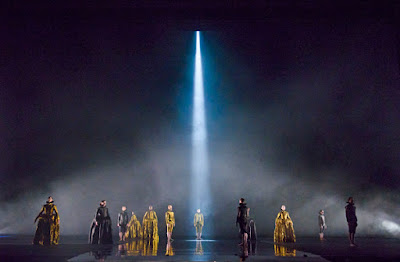As you can see from my blog it had a profound effect on us both and it did indeed start a continuing exploration of ballet which has been very rewarding. But how would the first revival of WOOLF WORKS compare - and would it have the same impact?
I am happy to be able to say that it led to a deeper, richer understanding of the work but also there was the added bonus this year of seeing it on the big screen at the Curzon Mayfair and also being able to appreciate the depth of Max Richter's music with it's release on cd.
Onstage we were blessed with practically the same cast as in 2015, the only major replacement being Calvin Richardson and his breathtaking pirouettes dancing the role of 'Evans' for the unwell Tristan Dyer in the MRS. DALLOWAY-inspired 'I Now, I Then'. The impact of seeing the company onstage was made even more exciting by seeing the same dancers a few days later on the live cinema screening, giving an opportunity to experience their talent closer than possible at the Opera House although there was some loss too, in particular the glorious digital stage image of the garden of Clarissa's imagined youth flooding the set.
McGregor has choreographed three ballets in distinct styles: 'I Now, I Then' is the most narrative; based on MRS DALLOWAY - and introduced with the only known recording of Virginia Woolf musing on the difficulty of using old English words in new ways - we see Clarissa Dalloway (sublime Alessandra Ferri) meeting old flame Peter Walsh (Gary Aves) and relives the glorious summer she spent as a teenager with Peter and her best friend, the free spirited Sally Seton, and how life seemed full of possibility and choice. The younger selves were danced wonderfully by Francesca Hayward, Federico Bonelli and Beatriz Stix-Brunell.
As Clarissa is lost in memories of what could have been we also see Septimus Smith (the astonishing Edward Watson) who is tortured with the lasting trauma of shell-shock from his experience in the WWI trenches. His wife Rezia (Akana Takada) tries to keep him engaged in life but he is lost in memories of his friend Evans (Richardson) who was killed before him. It is a perfect fusion of performance, choreography, design by Cigué, lighting by Lucy Carter - the moment the stage was suffused with glowing red when Septimus danced with Evans was glorious - and, almost a character of it's own, Max Richter's heartbreaking, longing music.
The second act 'Becomings' takes ORLANDO as it's inspiration and is the most abstract of the pieces although during one of the intervals for the screened event Wayne McGregor was interviewed by hosts Darcey Bussell and Clemency Burton-Hill and said he believed that no dance can be truly abstract as the human element will always lend a dance a narrative sense. Again Lucy Carter's lighting is thrilling: an overhead beam roams the dark stage picking out 12 dancers in varying degrees of glittering gold Elizabethan costumes before a cold laser beam illuminates two of them and we launch into McGregor's take on Woolf's exploration of gender fluidity.
As Richter's music roams from bone-crunching electro beats to minimal keyboard runs so McGregor's choreography changes from solos to duets to triple routines for his remarkable dancers - pushing their limbs into even more challenging shapes and attitudes; the exhilaration is in seeing male and female dancers fusing into just pure dance. With each segment, they slowly lose their Elizabethan costumes until they are in shades of grey, all dancing in and out of four overhead spotlights, all individual but all unified, until the lights cut out and the auditorium is criss-crossed with shafts of laserlight. Again the live screening was wonderful to showcase in detail the astonishing work of, among others, Sarah Lamb, Natalia Osipova, Steven McRae and Watson.
The final act is TUESDAY and takes it inspiration from THE WAVES but also references Woolf's suicide note written on Tuesday 25th March 1941, three days before she actually drowned in the River Ouse. McGregor has the inspired choice of Gillian Anderson reading the wrenching suicide note while a slow-motion film of crashing waves shows on a stage-wide screen all but dwarfing the stationary figure of Ferri beneath. Anderson's measured, hypnotic delivery leads you in to McGregor's slow meditation on love and loss, beautifully danced by Ferri and Federico Bonelli who are later joined by Sarah Lamb and an ensemble which also includes young students from the Royal Ballet School.
Ferri is astonishing in her poetry and control as she becomes the embodiment of Richter's dreamlike, ethereal music, solitary notes slowly coming together with Anush Hovhannisyan's soprano to wash over you with waves of strings and brass. There was one moment that haunts me: Alessandra Ferri starts a solo movement against the ensemble's choreography who slowly, three or four at a time, echo her until they are all bending and stretching as one, it's breathtakingly beautiful. Slowly the ensemble ebb away into the darkness at the back of the stage, as Bonelli lowers a prone Ferri onto the stage as the music slowly vanishes note by note...
As I have said, the live screening was a wonderful opportunity to see the dancers closer than possible in the theatre and there were the added extras of interviews with Wayne McGregor and Max Richter as well as Maggie Smith reading passages from THE WAVES as well as Virginia's memoir MOMENTS OF BEING.
As I have written this I have been able to relive the experience by playing the cd THREE WORLDS of Richter's score; I wondered if it would work separately from the experience of seeing it with the dancers but it works beautifully. It has been great to be able to explore this work in depth for the past two weeks - I would love the opportunity to see it again.









No comments:
Post a Comment